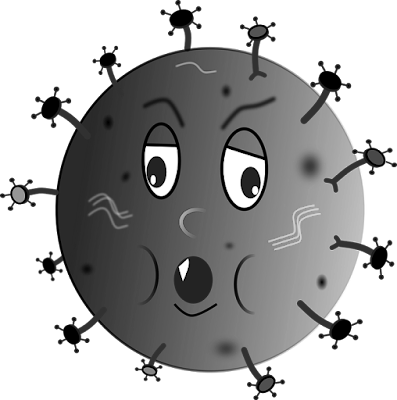Is virus a cell?
Everyone will have a cold in their lifetime, at this time
you will cough and runny nose, it feels terrible. The worst thing about a cold
is that although you can take medicine to improve symptoms, but you can’t do
the same as when you get streptococcal laryngitis or toothache. Eat antibiotics
to treat colds,
why
Okay, let ’s talk about the cause of the cold: the virus
Colds are diseases caused by viral infections "Modern Cytology" says:
Each organism is composed of one or more cells but viruses,
not cells Viruses are not considered biological because they lack of many life
characteristics. But to call them inanimate is also controversial Antibiotics
can kill bacteria, such as E. coli live cells. Antimycotic drugs can be used to
kill molds that cause Hong Kong feet. Molds are also living cells. Viruses are
neither bacteria nor mold.
Nor can you classify viruses as prokaryotic bacteria
or eukaryotic cells because the virus is not even a cell.
Image: Simple diagram of virus
What does the structure of the virus look like?
First, the virus is much smaller than the cell. You have to
use an electron microscope to see the virus. The shape of the virus is
ever-changing. Virus replication must have-host. Virus replication will cause
problems with the host, whether the host is you, an insect, a plant, or this
bacterium. Viruses are very specific to the host they want to infect. Anything
alive can become a host for viruses. Because there are mechanisms in the cell
that the virus depends on to replicate
Next, let ’s talk about the two circulating modes of virus
replication
The first is the "lytic cycle". During the lysis
period, the virus attaches to its host cell. Remember, the virus is very
specific. It connects to the receptor on the surface of the cell, so that it
can be docked. Next, the virus transfers its own genetic material,May be DNA or
RNA Inject cells. Some viruses are swallowed entirely into cells. You might
think that the cell will definitely notice the invasion. Virus DNA, RNA, or a
complete virus but in many cases, this is not the case. Not only did the cells
receive the genetic material of these viruses.
Cells use their own resources to help the virus work. They
began to replicate a large number of viruses, and the number was so large that
they broke the host ’s cell membrane. explosion! Dissolve! ! As a result, a
newly reproduced army of viruses emerged from the cells Infect surrounding
cells. This is called the "cracking period". By the way, for cells,
the dissolution of cell membranes is fatal after the cell membrane ruptures,
the cell has only one dead path.
Another cycle is called the "lysogenic cycle" Remember,
this is a relatively long word correspondingly, this is a relatively long,
sneaky loop. The viruses that entered this cycle did the same thing at the
beginning: Inject genetic material into cells. But this time, these genetic
material hiding in the host's genetic material. Later, when the host makes new
cells, not only copied her genetic material also replicates the genetic
material of the virus. Then, when these daughter cells divide into new cells, also
copied her own genetic material and viral genetic material. This is the
so-called "latent dissolution period".
This period does not seem to be too threatening. But when it
was induced into the cracking period because all cells contain viral genetic
material. The cells begin to assemble a large amount of virus, and the Daizhi
is large. As for the reasons that induce the cells to enter the lysis phase, It's
all-encompassing. Sometimes, it may be the stimulation of a certain chemical
substance; Sometimes it is caused by the host ’s lack of food.
Back to the cold. Most of the time, a cold will help you. Your
immune system will naturally handle it. Medicines will relieve your symptoms
and make you more comfortable. Unfortunately, some viruses are very complex,
such as HIV-AIDS-causing virus is very specific. It will connect to the CD4
glycoprotein on the surface of some special cells. E.g. T cells. This
particular target of attack will cause great problems.
Because T cells protect
the body ’s immune system, plays a very important role. Because HIV targets
these immune cells, people infected with HIV, will not resist infection. There
are drugs now that can prevent HIV from replicating quickly. People are also
constantly studying how to prevent viruses from attaching to cells. Once the
virus cannot attach, it cannot inject genetic material. In the face of viruses,
the biggest challenges are: Many viruses, including HIV, "mutate". Therapies
that target a certain virus type may not be effective for mutants. Talking
here, you might think: about viruses.
Isn't there a good thing?
Hmm ~ viruses play an important role in gene therapy, of
course there are many spaces worth exploring. Also, remember we mentioned that
some viruses can infect other species, for example insects. Some viruses can
infect certain pests. This virus can be an alternative to chemical pesticides. For
example, nuclear polyhedrosis virus is an object worth further exploration.
However, whether it
is a chemical or viral insecticide, We should all think about it. Their impact
on the ecological environmentThe above is the report of Sister Amoeba. I hope
you will keep a curious heart forever. The name sounds cool, but it is actually
a virus that attacks bacteria. Although people love to paint this virus, but
know Virus appearance is changeable.
All viruses have a common characteristic:
They all have certain types of genetic material. These
genetic materials can be DNA or RNA. Viruses usually have an outer membrane of
a certain protein, we call it the capsid. The shell can protect genetic
material such as DNA or RNA. Viruses can also have other structures, some
viruses have special enzymes while some viruses have a coat. These structures
may be helpful for virus replication.
Virus vs
cell
You're in line at the supermarket when, oh, oh, someone
sneezes on you. The influenza virus enters the lungs and reaches a cell in the respiratory wall. Every being on the planet is made of cells, from
single-celled bacteria even the giant blue whale, or you.
Image: Influenza virus
Each cell is surrounded by a cell membrane, a flexible
layer composed of fats and proteins, that surround and protect the
internal components. It is semipermeable, I mean, let certain things in and out
but it blocks others.
The membrane is covered by small protrusions, they have
functions like the cells stick or join the necessary nutrients. Animals and
vegetables have membranes. vegetables have a cell wall, formed by rigid
cellulose that gives structure to the plant.
The virus cell that enters the lungs is cunning. Pretending
to be friends, binds to a protrusion of the cell membrane, traversing it
and reaching the cell. When the virus enters, the cell recognizes its error. An
enemy has entered! There are also some enzymes that reduce the virus to pieces.
Then they send one of the pieces through the membrane, and they warn
neighboring cells about the invader. A neighboring cell sees it and it
immediately goes into action.
You have to make antibodies, proteins that will end with the
invading virus. This process begins at the core. The nucleus contains our DNA, that
tells the cells how to do everything what is necessary for the body to
function. A part of our DNA contains instructions that tell cells how
to create antibodies. Enzymes find the right section of DNA and they copy these
instructions, it is the messenger RNA. The messenger RNA leaves the nucleus to execute its orders. Messenger RNA goes to a ribosome.
There may be 10 million ribosomes in a human cell, all of
them in the form of a bow, forming the endoplasmic reticulum. This ribosome
reads the instructions from the nucleus. Take amino acids and link
them one by one creating an antibody that will fight the virus. But before
that, the antibody has to leave the cell. The antibody is directed to
the Golgi apparatus. Here they prepare it to leave the cell. Covered by a
bubble equal to the cell membrane. The Golgi apparatus also instructs
the antibody so that it reaches the edge of the cell.
Image: Cell organells of animal cell
Once there, the bubble fuses with the cell membrane. The
cell expels the antibody, and goes to locate the virus. Bubble residue is
removed by lysosomes and its parts are recycled over and over again. Where do
you get the energy to do this? That is the role of the mitochondria. To
produce energy, it takes oxygen, For this reason alone we breathe, and adds
electrons from the food to form water molecules. This process creates an
energy molecule called ATP that the cell distributes by its components. Plant
cells create energy differently Have chloroplast that combine CO2 and
water with the light energy of the sun to create oxygen and sugar, a form of
chemical energy.
All parts work together to make things work well and all
cells do the same so there are no problems. They are a lot of cells. Scientists
estimate that there are about 37 trillion cells.











0 Comments